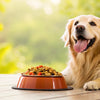How to Put Weight on a Dog with Pancreatitis: Essential Strategies for Care and Nutrition
- Houndsy
Table of Contents
- Introduction
- Understanding Pancreatitis in Dogs
- The Role of Diet in Managing Pancreatitis
- Practical Feeding Tips
- Encouraging Your Dog to Eat
- Conclusion
- FAQ
Introduction
Did you know that pancreatitis is one of the most common gastrointestinal emergencies in dogs? This condition leads to inflammation of the pancreas, and for many loving pet parents, it brings the added challenge of ensuring their furry friends maintain a healthy weight during recovery. If you're grappling with the worry of how to put weight on a dog with pancreatitis, you're not alone. Many pet owners face this dilemma, especially when their dogs have lost weight due to a decreased appetite or dietary restrictions.
Understanding how to navigate this complex condition is crucial for both your dog's health and your peace of mind. In this comprehensive guide, we will delve into the nuances of pancreatitis, how it affects your dog’s ability to gain weight, and practical strategies that can help. By the end of this article, you'll have a clearer understanding of how to support your dog's nutritional needs during this challenging time, while also promoting overall well-being.
We'll cover the following topics:
- What pancreatitis is and its symptoms
- The dietary restrictions associated with pancreatitis
- Nutritional strategies for weight gain
- Practical feeding tips and meal ideas
- The role of the Houndsy Kibble Dispenser in managing feeding routines
Together, let's explore how to lovingly care for our pets during their recovery, ensuring they not only regain their lost weight but thrive.
Understanding Pancreatitis in Dogs
What is Pancreatitis?
Pancreatitis is the inflammation of the pancreas, a crucial organ responsible for producing digestive enzymes and insulin. In dogs, this inflammation can occur in two forms: acute and chronic. Acute pancreatitis happens suddenly and can be severe, while chronic pancreatitis develops slowly and may involve recurring episodes.
Symptoms of Pancreatitis
Recognizing the symptoms of pancreatitis can be lifesaving. Common signs include:
- Vomiting and diarrhea
- Abdominal pain and discomfort
- Decreased appetite or refusal to eat
- Lethargy and weakness
- A hunched posture or a "praying" position (front legs down with rear end raised)
If your dog exhibits any of these symptoms, it’s essential to consult your veterinarian immediately for a proper diagnosis and treatment plan.
Causes of Pancreatitis
Pancreatitis can be triggered by various factors, including:
- High-fat diets or dietary indiscretion (e.g., eating rich table scraps)
- Obesity
- Certain medications or toxins
- Underlying health conditions, such as diabetes or hyperlipidemia (high levels of fat in the blood)
Understanding these triggers can help prevent future episodes and allow you to make informed dietary choices for your dog.
The Role of Diet in Managing Pancreatitis
Dietary Restrictions
Managing a dog with pancreatitis requires careful attention to diet. Foods high in fat can exacerbate the condition, so it’s critical to avoid:
- Fatty meats (e.g., pork, beef)
- Processed human foods
- High-fat treats
- Dairy products
Instead, a low-fat, easily digestible diet is recommended. This typically involves feeding your dog a bland diet until they stabilize, followed by a gradual reintroduction of regular food.
Nutritional Strategies for Weight Gain
When it comes to putting weight on a dog with pancreatitis, it’s essential to focus on calorie-dense, low-fat options. Here are some effective strategies:
1. High-Calorie, Low-Fat Foods
Opt for foods that provide essential calories without overwhelming the pancreas:
- Lean Proteins: Skinless chicken, turkey, or fish are excellent choices. They provide high-quality protein without excess fat.
- Complex Carbohydrates: Incorporate easily digestible carbs like white rice, sweet potatoes, or oatmeal, which can help add calories without stressing the digestive system.
- Low-Fat Wet Food: Consider options specifically formulated for dogs with pancreatitis. These foods are often higher in moisture and easier to digest.
2. Nutritional Supplements
Adding supplements can be an effective way to boost calories:
- High-Calorie Gels: Products like Ready Cal can provide concentrated nutrition without putting stress on the pancreas.
- Digestive Enzymes: These can aid in digestion and help your dog absorb more nutrients from their food.
- Fish Oil: While fish oil is high in fat, it consists of omega-3 fatty acids that may help reduce inflammation. Always consult your vet before adding new supplements.
3. Frequent, Small Meals
Feeding smaller, more frequent meals can prevent overloading the digestive system while still providing adequate nutrition. Aim for 4-6 small meals throughout the day, which can help maintain energy levels and encourage weight gain.
Practical Feeding Tips
Meal Ideas for Dogs with Pancreatitis
Creating meals that align with your dog’s dietary needs doesn’t have to be daunting. Here are some meal ideas that are both nutritious and appealing to your pup:
- Chicken and Rice: Boil skinless chicken breast and serve it with plain white rice. This classic meal is gentle on the stomach and easy to digest.
- Sweet Potato Mash: Cook sweet potatoes and mash them up for a tasty, nutrient-rich side dish.
- Turkey and Pumpkin Mix: Combine lean ground turkey with canned pumpkin (not pie filling) for a fiber-rich, palatable meal.
Using the Houndsy Kibble Dispenser
Incorporating the Houndsy Kibble Dispenser into your feeding routine can enhance the experience for both you and your dog. With ergonomic design and perfect portion control, it makes feeding easy and consistent. This can be especially helpful when managing multiple small meals, ensuring your dog gets the right amount at each feeding.
Explore the Houndsy Kibble Dispenser here to see how it can simplify your dog’s feeding routine.
Encouraging Your Dog to Eat
Creating a Positive Feeding Environment
Dogs can be sensitive to their feeding environment, especially when recovering from an illness. Here are a few tips to encourage your dog to eat:
- Keep the Area Calm: Minimize distractions during mealtime to help your dog focus on eating.
- Use Enticing Aromas: Warm up food slightly to enhance its aroma, making it more appealing.
- Hand-Feeding: Sometimes, hand-feeding can encourage a reluctant eater to consume their food.
Monitor Their Progress
Keep track of your dog’s weight and eating habits. Regular weigh-ins can help you notice trends and adjust their diet or feeding routine as necessary. Consult your veterinarian to ensure your dog is on the right track to regaining their weight.
Conclusion
Caring for a dog with pancreatitis can be a challenging journey, but with the right knowledge and tools, we can make it manageable. By focusing on low-fat, calorie-dense foods, frequent small meals, and a positive feeding routine, we can help our furry friends regain their strength and health while putting on the necessary weight.
As we navigate this journey together, remember that every dog’s needs are different. Always consult your veterinarian for tailored advice and to ensure your dog receives the best care possible.
For those looking to elevate their dog’s feeding experience, consider the Houndsy Kibble Dispenser, designed to simplify feeding and promote a consistent, healthy routine. Discover more about this innovative product here.
FAQ
How long does it take for a dog to recover from pancreatitis?
Recovery time can vary depending on the severity of the pancreatitis and the dog’s overall health. Most dogs with mild cases can begin to recover within a few days, while more severe cases may take weeks.
Can I feed my dog human food if they have pancreatitis?
It’s essential to be cautious with human food. Stick to low-fat, simple ingredients, and always consult your vet before introducing new foods.
How can I tell if my dog is gaining weight?
Regular weigh-ins and tracking your dog’s body condition score can help you monitor weight gain. You should also observe their energy levels and overall health.
Should I give my dog treats while they are recovering?
Treats should be low-fat and given in moderation. Always choose options that are safe for dogs with pancreatitis and consult your vet for recommendations.
What if my dog refuses to eat?
If your dog refuses to eat for more than 24 hours, consult your veterinarian. They can provide guidance and may suggest alternatives to stimulate your dog’s appetite.
By following these guidelines and being attentive to your dog's needs, we can help them navigate the challenges of pancreatitis while ensuring they stay nourished and healthy.












